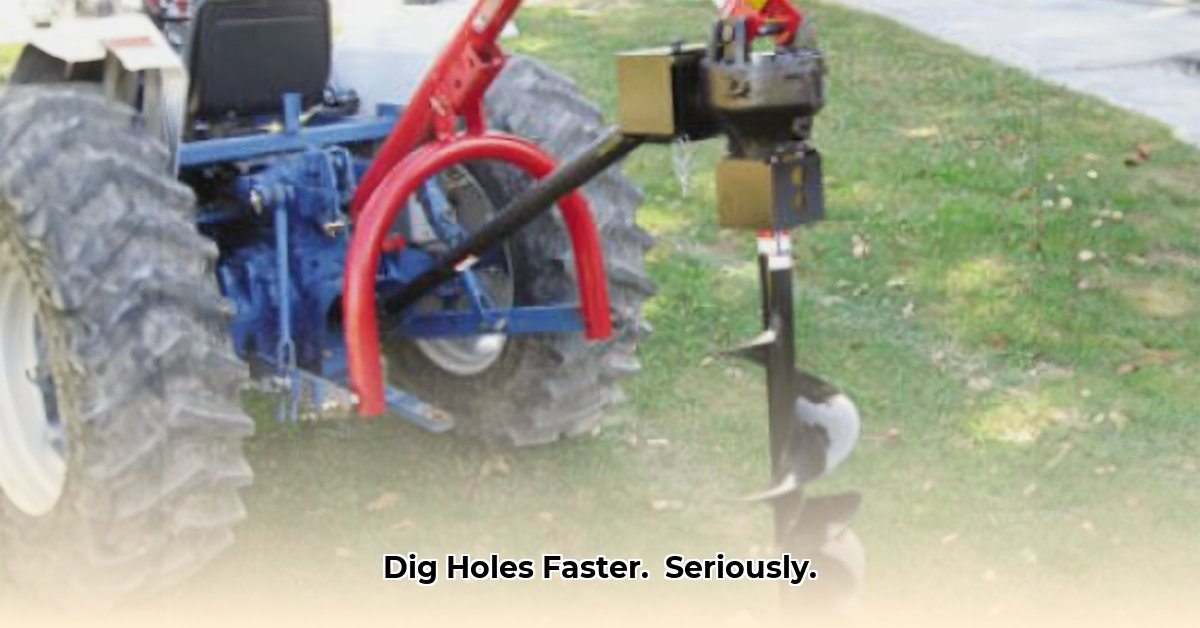
Tractor Hole Diggers: A Modern Farming Essential
Tired of backbreaking labor digging holes for fence posts or planting trees? Tractor-mounted post hole diggers offer a significant boost in farm efficiency, saving you time and effort on a wide range of tasks. This article explores the benefits of these powerful tools, guiding you through selection, safe operation, and essential maintenance to maximize their lifespan and your farm's productivity. For parts and maintenance information, check out this helpful resource: Tractor Supply Parts.
Time Savings and Increased Productivity
Manual digging is slow and physically demanding. A tractor post hole digger drastically reduces digging time, freeing you up for other critical farm operations. This translates to meeting deadlines more easily, improving overall farm output, and even allowing for some much-needed downtime. How much time can you realistically save? Farmers report efficiency gains of up to 75% compared to manual digging, depending on soil conditions and project scale.
Choosing the Right Digger: Matching Power to Your Needs
Selecting the appropriate digger involves considering your tractor's size and power. Smaller tractors typically pair with compact diggers, while larger farms benefit from heavy-duty models capable of handling substantial workloads. Overpowering or underpowering the system can lead to inefficiency or damage. Remember, the right size ensures both sustainable operations and optimum efficiency. What's the best size for your farm? Carefully analyze your typical projects and soil conditions.
Auger Bit Selection: The Key to Efficient Digging
The auger bit is crucial for successful hole digging. Consider these factors when choosing the right bit:
- Post Size: The bit's diameter must match the post size to prevent wobbling or overly tight fits.
- Soil Type: Hard, rocky soils require robust bits designed for increased friction resistance, while softer soils may benefit from more efficient, lighter bits.
- Project Type: Tree planting necessitates different hole dimensions and depths compared to fence post installation.
Using the incorrect bit leads to broken bits, time loss, and potential damage to the digger itself. A well-chosen bit is an investment in efficiency and longevity.
Essential Maintenance for Extended Lifespan
Preventative maintenance is crucial for any farm equipment. For your post hole digger, this includes:
- Regular Inspections: Inspect the auger bit, drive shaft, and other moving parts before and after each use for wear and tear, bending, cracks, or excessive wear.
- Lubrication: Keep moving parts well-lubricated to minimize friction and prevent premature wear. Refer to your owner's manual for specific lubricant recommendations.
- Sharp Bits: Dull bits reduce efficiency and increase breakage risk. Regularly sharpen or replace dull bits.
- Proper Storage: Clean your digger after each use and store it in a dry, protected area to prevent rust and damage.
Safety Procedures: Prioritizing Safety Above All Else
Safety is paramount when operating farm equipment. Always adhere to these safety guidelines:
- Maintain Safe Distance: Keep a minimum of 15-25 feet from the running digger to avoid rotating components.
- Follow Manufacturer Instructions: Carefully read and follow all manufacturer instructions.
- Emergency Procedures: Familiarize yourself with emergency stop procedures and PTO disengagement techniques. "Ignoring safety protocols can lead to serious accidents," advises Dr. Emily Carter, Agricultural Engineer at Purdue University.
Cost vs. Longevity: A Long-Term Investment
While the initial cost of a quality post hole digger may be significant, it's a long-term investment. High-quality, heavy-duty models often justify their price through durability and longevity. American-made models are typically recognized for robust construction and reliability, which translates to fewer repairs and a longer lifespan, reducing overall long term costs. However, consistent maintenance greatly contributes to extending the digger's lifespan regardless of origin.
Addressing Potential Issues
Understanding potential problems and their solutions is key to avoiding costly repairs and downtime. Common issues include auger bit failure, drive shaft failure, and tractor PTO malfunctions. Regular inspection, proper maintenance, and operator training significantly reduce the likelihood of these issues. Operator error, for example, accounts for a substantial percentage of accidents, stressing the importance of thorough training and adherence to safety guidelines. "Regular maintenance is crucial; it's not just about fixing problems, it's about preventing them," notes John Miller, a seasoned farmer from Iowa.
Choosing the Best Tractor Post Hole Digger for Long-Term Cost Effectiveness
Three Pivotal Points for Choosing a Post Hole Digger:
- Prioritize safety features and operator training to minimize accident risks.
- Select the appropriate power source (PTO or hydraulic) based on your tractor's capabilities and the frequency of use.
- Regular maintenance and proper bit selection are key to maximizing the digger's longevity and cost-effectiveness.
Choosing the right digger involves considering factors beyond the initial purchase price. PTO-driven models are often less expensive upfront but may demand more maintenance compared to hydraulic models which offer greater efficiency, precision, and safety, justifying the higher upfront investment for frequent use. Regular maintenance, coupled with the correct auger bit selection, significantly extends the lifespan of your equipment, minimizing long-term costs. Prioritize quality and safety for a sound long-term investment.